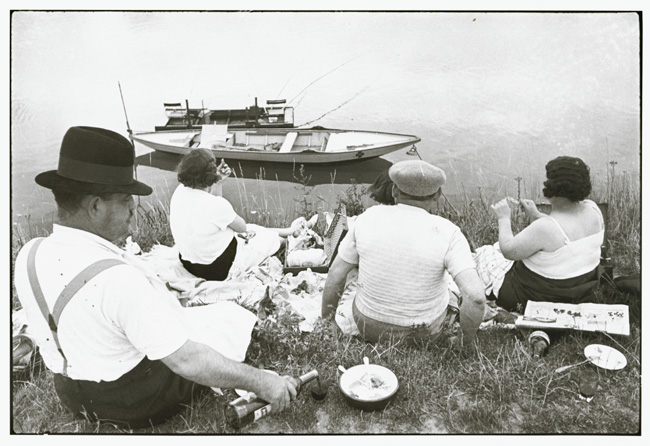Henri Cartier-Bresson, Sunday on the banks of the River Marne, 1938

The tranquility reigns and the river is calm, nothing more than a gentle breeze is announced. The men have finished their meal, and the latter fills another glass of wine, oblivious to something the woman with crossed legs in front of him seems to try to point in an effort to counteract the prevailing silence. The second woman is reluctant to abandon the delicacy she prepares to taste. For his part, the husband has already set down his plate and has withdrawn his glass, participating in the futile attempt to counteract the melancholy, while hiding from the view - in an unconscious protective act - a fifth element, probably his daughter. The two couples, although on their backs, seem to reveal all their truth, their essence: a working-class family, coming from a rural and quiet environment, away from the noises of machines and the city... the world for them seems to be just there and no more.
I do not usually associate authors with their works, and in this particular image I never really understood what made it impossible for me to erase. Was it the apparent banality of the subject, the simple curiosity of trying to understand why it was this image as important and iconic of a work as vast as that of Cartier-Bresson?
Much can be said about how he achieved this composition, which many compare with paintings such as Un Dimanche Après-midi à l'ille de la Grande Jatte by George Seurat and Rue de Paris, Temps de Pluie by Gustave Caillebotte ... the image, in black and white, "is a colorful melancholy”, so real that it presents itself. Inseparable from his Leica, he almost always wore a 50mm lens and this makes the proximity to the subject clear, suggesting in a first analysis that he interacted with those people and waited for his decisive moment to "shoot." It seems clear that this was so, were not so strong the sensation raised: the absence of the photographer. This is, in fact, what fascinates me in this image, its Punctum if we want: the border that is almost imperceptible but present between the observer and the subject. The fine line that divides the space that the photographer has managed to occupy without (seemingly) intruding into the existing scenario. Almost as if his presence was not perceptible, the only sign of which is the fact that the photograph exists, and to prove that Cartier-Bresson was there and was part of that moment.
The biggest achievement of this image is therefore the ability to transport the Spectatore to the site and feel - more than see - that is there, as an observer and beyond the photographer's lens. This is the same magic that I find in a movie theatre, but while the big screen transports the spectator from reality to fiction, photography - this photograph - does the reverse: here we are fiction, because we were not there, but we feel part of the reality that the image evokes. One of the biggest challenges in photography is perhaps the one that is imposed from the moment the photographer realizes that he is, in fact - "(...) from the moment that I feel looked at by the lens, everything changes : I prepare myself for the pose, I instantly manufacture another body, I morph into an image "(BARTHES, 1980, p.25) - and the opposite of all this appears in this image, as if more than the absence of the camera were also the lack of a possible photographer. Cartier-Bresson was in fact the "invisible man of the crowds" (MACÉ, 2004, p. 7) as he himself confirmed when he wrote: "My notoriety is a heavy burden: (...) I spent my whole life trying be imperceptible in order to observe better. " To reinforce all this, technique without artifice - "(...) it is important insofar as we must dominate it to convey what we see" - and the formal and balanced composition, a constant in his works, the extension of his gaze through the machine, translated in this image into reality and honesty.
Photography is rather timeless but its date, combined with content, becomes even more important if we consider the context in which it is inserted: the idyll and tranquility present in this 1938 image seems to serve as a contrast to what would follow later: in 1939 the Germans would invade Poland by beginning World War II. France was soon to be occupied, and Cartier-Bresson was taken prisoner.